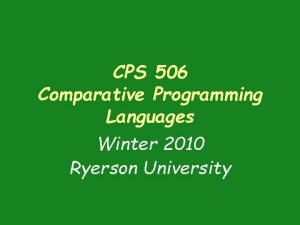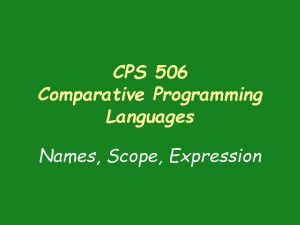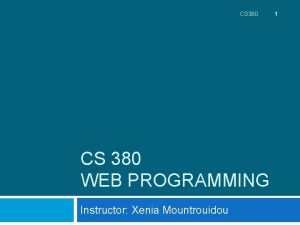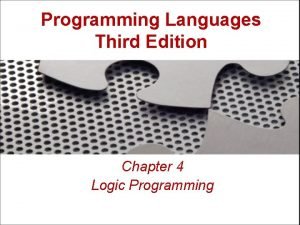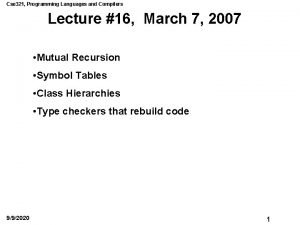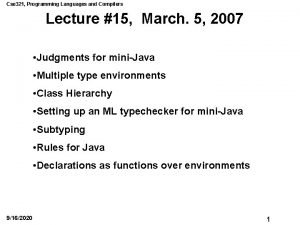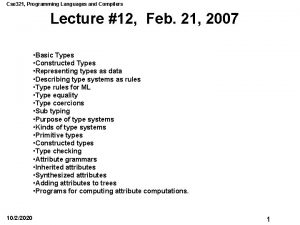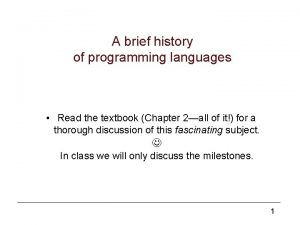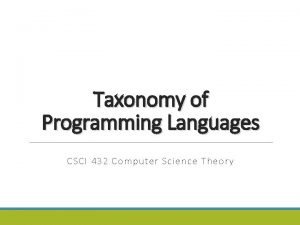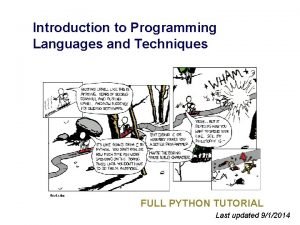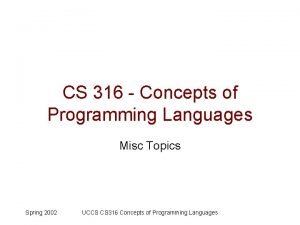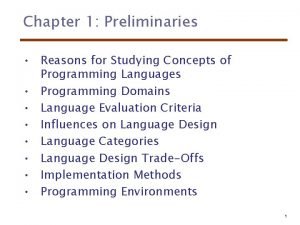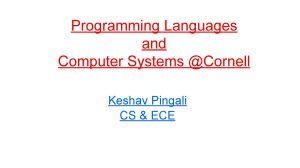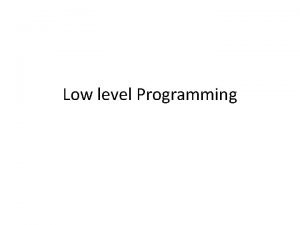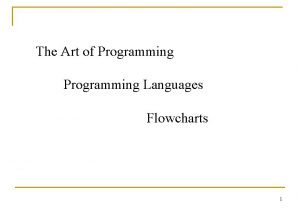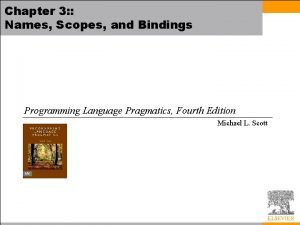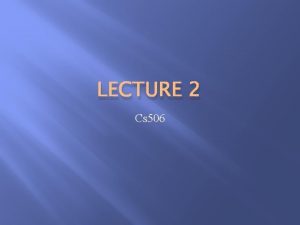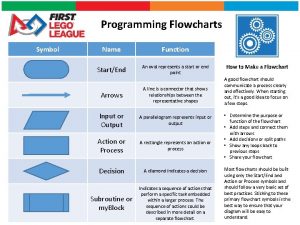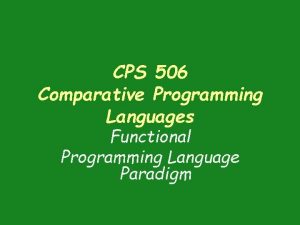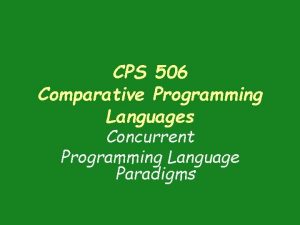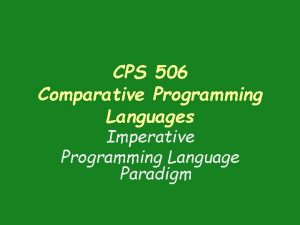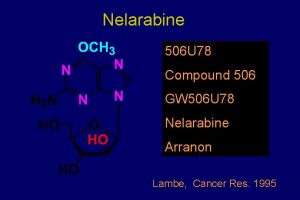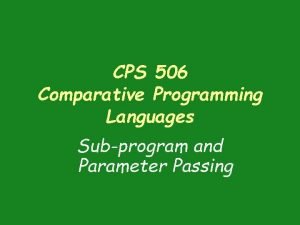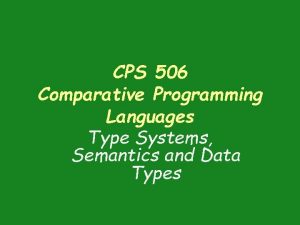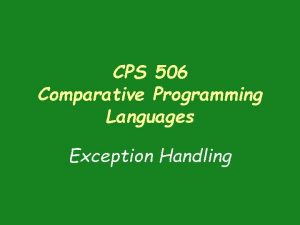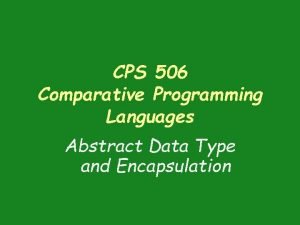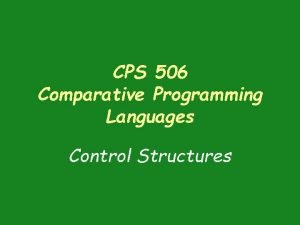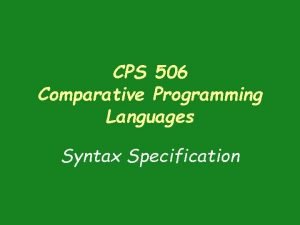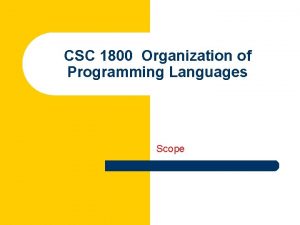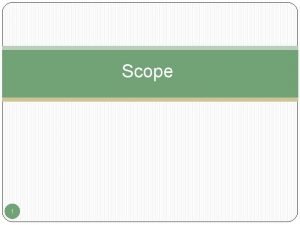CPS 506 Comparative Programming Languages Names Scope Expression

















































- Slides: 49

CPS 506 Comparative Programming Languages Names, Scope, Expression

Names • Design issues – Case sensitivity – Special Words (Keywords, Reserve words) • Length – If too short, they cannot be meaningful – Language examples: • FORTRAN 95: maximum of 31 • C 99: no limit but only the first 63 are significant; also, external names are limited to a maximum of 31 • C#, Ada, and Java: no limit, and all are significant • C++: no limit, but implementers often impose one 2

Names • Special characters – PHP • Variable names begin with dollar signs • Case sensitive • Starting with a letter or underscore $var = 'Bob'; $Var = 'Joe'; echo "$var, $Var"; 3

Names • Special characters – Perl: all variable names begin with special characters, which specify the variable’s type • Case sensitive • Starting with a letter or underscore • $ for scalar variable $yname="test"; • @ for array variable @years=(2003, 2004, 2005); • % for hash variable %nav. Bar=('1' => 'index‘, '2' => 'perl‘, '3' => 'php’); 4

Names • Special characters – Ruby: • • Local variables start with lowercase letter Global variables start with $ Instance variables begin with @ Class variables begin with @@ – Python • Case sensitive • Starting with a letter or underscore (Details in their own sessions) 5

Names • Case sensitivity – Disadvantage: readability (names that look alike are different) • Names in the C-based languages are case sensitive • Names in others are not • Worse in C++, Java, and C# because predefined names are mixed case (e. g. Index. Out. Of. Bounds. Exception) 6

Names • Special words – An aid to readability; used to delimit or separate statement clauses • A keyword is a word that is special only in certain contexts, e. g. , in Fortran – Real Var. Name (Real is a data type followed with a name, therefore Real is a keyword) – Real = 3. 4 (Real is a variable) • A reserved word is a special word that cannot be used as a userdefined name • Potential problem with reserved words: If there are too many, many collisions occur (e. g. , COBOL has 300 reserved words!) 7

Variables • Six attributes – Name – Address (l-value) – Type – Value (r-value) – Scope – Lifetime 8

Scope • The scope of a variable is the range of statements over which it is visible • The nonlocal variables of a program unit are those that are visible but not declared there • The scope rules of a language determine how references to names are associated with variables 9

Scope • Static scope – Scope of a variable can be statically determined prior to execution – C, Pascal, Java, Scheme, ML, Haskell • Dynamic Scope – Is based on the calling sequence of subprograms, and thus can be determined only at run-time – Original LISP, logo, Emacs LISP • Common LISP and Perl have both 10

Scope (con’t) • To connect a name reference to a variable, you (or the compiler) must find the declaration – Search process: search declarations, first locally, then in increasingly larger enclosing scopes, until one is found for the given name – Enclosing static scopes (to a specific scope) are called its static ancestors; the nearest static ancestor is called a static parent 11

Scope (con’t) • Variables can be hidden from a unit by having a "closer" variable with the same name – Ada allows access to these "hidden" variables E. g. unit. name 12

Scope (con’t) • Example in C: void sub() { int count; while (. . . ) { int count; count++; . . . } … } - Note: legal in C and C++, but not in Java and C# - too error-prone 13

Labeled Namespaces • A labeled namespace is any language construct that contains – Definitions – A region of the program where those definitions apply – A name that can be used to access those definitions from outside the construct • ML has one called a structure… 14

ML Structures structure Fred = struct val a = 1; fun f x = x + a; end; • A little like a block: a can be used anywhere from definition to the end • But the definitions are also available outside, using the structure name: Fred. a and Fred. f 15

Other Labeled Namespaces • Namespaces that are just namespaces: – C++ namespace – Modula-3 module – Ada package – Java package • Namespaces that serve other purposes too: – Class definitions in class-based objectoriented languages 16

Example public class Month { public static int min = 1; public static int max = 12; … } • The variables min and max would be visible within the rest of the class • Also accessible from outside, as Month. min and Month. max 17

Namespace Advantages • Two conflicting goals: – Use memorable, simple names like max – For globally accessible things, use uncommon names like max. Supplier. Bid, names that will not conflict with other parts of the program • With namespaces, you can accomplish both: – Within the namespace, you can use max – From outside, Supplier. Bid. max 18

Declaration Order • C, C++, Java, and C# allow variable declarations to appear anywhere a statement can appear – In C, C++, and Java, the scope of all local variables is from the declaration to the end of the block – In C#, the scope of any variable declared in a block is the whole block, regardless of the position of the declaration in the block » However, a variable still must be declared before it can be used 19

Declaration Order (con’t) • In C++, Java, and C#, variables can be declared in for statements • The scope of such variables is restricted to the for construct 20

Dynamic Scope • Based on calling sequences of program units, not their textual layout (temporal versus spatial) • References to variables are connected to declarations by searching back through the chain of subprogram calls that forced execution to this point 21

Scope Example Big - declaration of X Sub 1 - declaration of X. . . call Sub 2. . . - reference to X. . . Big calls Sub 1 calls Sub 2 uses X . . . call Sub 1 … 22

Scope Example (con’t) • Static scoping • Reference to X is to Big's X • Dynamic scoping • Reference to X is to Sub 1's X • Evaluation of Dynamic Scoping: • Advantage: convenience • Disadvantages: – While a subprogram is executing, its variables are visible to all subprograms it calls – Impossible to statically type check – Poor readability- it is not possible to statically determine the type of a variable 23

Scope and Lifetime • Scope and lifetime are sometimes closely related, but are different concepts • The scope of a variable specifies where a variable’s name can be used in a program • The lifetime of a variable specifies how long the storage for that variable exists in memory. • Consider a static variable inside a C function – Its scope is static and local to that function – Its lifetime extends over the entire execution of the program. 24

Expression • Expressions are the fundamental means of specifying computations in a programming language • To understand expression evaluation, need to be familiar with the orders of operator and operand evaluation • Essence of imperative languages is dominant role of assignment statements 25

Expression (con’t) • Arithmetic Expression – Arithmetic evaluation was one of the motivations for the development of the first programming languages – Arithmetic expressions consist of • Operators • Operands • Parentheses • function calls 26

Expression (con’t) • Design issues for arithmetic expressions – Operator precedence rules? – Operator associativity rules? – Order of operand evaluation? – Operand evaluation side effects? A + FUN(A) int b = 10; System. out. println((b=3) + b); – Operator overloading? – Type mixing in expressions? 27

Expression (con’t) • Operators – A unary operator has one operand b = !a; – A binary operator has two operands c = a + b; – A ternary operator has three operands int abs. Value = (a < 0) ? -a : a; 28

Expression (con’t) • Operator Precedence Rules – The operator precedence rules for expression evaluation define the order in which “adjacent” operators of different precedence levels are evaluated – Typical precedence levels • parentheses • unary operators • ** (if the language supports it) • *, / • +, 29

Expression (con’t) • Operator Associativity Rules – For expression evaluation define the order in which adjacent operators with the same precedence level are evaluated – Typical associativity rules • Left to right, except **, which is right to left • Sometimes unary operators associate right to left (e. g. , in FORTRAN) • APL and Smalltalk have no operator precedence rules – APL: strictly right to left – Smalltalk: strictly left to right – Precedence and associativity rules can be overridden with parentheses 30

Expression (con’t) • Expressions in Ruby – All arithmetic, relational, and assignment operators, as well as array indexing, shifts, and bit-wise logic operators, are implemented as methods • One result of this is that these operators can all be overridden by application programs 31

Expression (con’t) • Conditional Expressions – C-based languages (e. g. , C, C++) – An example: average = (count == 0)? 0 : sum / count – Evaluates as if written like if (count == 0) average = 0 else average = sum /count 32

Expression (con’t) • Operand evaluation order – Variables: fetch the value from memory – Constants: sometimes a fetch from memory; sometimes the constant is in the machine language instruction – Parenthesized expressions: evaluate all operands and operators first – The most interesting case is when an operand is a function call 33

Expression (con’t) • Functional side effects – When a function changes a two-way parameter or a non-local variable • Problem with functional side effects – When a function referenced in an expression alters another operand of the expression; e. g. , for a parameter change: a = 10; /* assume that fun changes its parameter */ b = a + fun(&a); 34

Expression (con’t) • Two possible solutions to the problem – Write the language definition to disallow functional side effects • No two-way parameters in functions • No non-local references in functions • Advantage: it works! • Disadvantage: inflexibility of one-way parameters and lack of non-local references – Write the language definition to demand that operand evaluation order be fixed • Disadvantage: limits some compiler optimizations • Java requires that operands appear to be evaluated in left-toright order 35

Overloaded Operators • Use of an operator for more than one purpose is called operator overloading • Some are common (e. g. , + for int and float) • Some are potential trouble (e. g. , * in C and C++) – Loss of compiler error detection (omission of an operand should be a detectable error) – Some loss of readability • C++ and C# allow user-defined overloaded operators • Potential problems: – Users can define nonsense operations – Readability may suffer, even when the operators make sense 36

Relational and Boolean Expressions • Relational Expressions – Use relational operators and operands of various types – Evaluate to some Boolean representation – Operator symbols used vary somewhat among languages ( !=, /=, ~=, . NE. , <>, #) • Java. Script and PHP have two additional relational operator, === and !== – Similar to their cousins, == and !=, except that they check both value and type – PHP “ 0 == false” “ 0 === false” 37

Relational and Boolean Expressions • Boolean Expressions – Operands are Boolean and the result is Boolean – Example operators FORTRAN 77. AND. . OR. . NOT. FORTRAN 90 and or not C Ada && || ! and or not xor 38

Relational and Boolean Expressions • Boolean type in C – C 89 has no Boolean type--it uses int type with 0 for false and nonzero for true – One odd characteristic of C’s expressions a < b < c is a legal expression, but the result is not what you might expect • Left operator is evaluated, producing 0 or 1 • The evaluation result is then compared with the third operand (i. e. , c) 39

Short Circuit Evaluation • • • An expression in which the result is determined without evaluating all of the operands and/or operators Example: (13*a) * (b/13– 1) – If a is zero, there is no need to evaluate (b/13 -1) Problem with non-short-circuit evaluation index = 1; while (index <= length) && (LIST[index] != value) index++; – When index=length, LIST [index] will cause an indexing problem (assuming LIST has length -1 elements) 40

Short Circuit Evaluation (con’t) • C, C++, and Java – use short-circuit evaluation for the usual Boolean operators (&& and ||) • Ada – programmer can specify either short-circuit is specified with “and then” and “or else” • Short-circuit evaluation exposes the potential problem of side effects in expressions e. g. (a > b) || (b++ / 3) 41

Assignment Statements • The general syntax <target_var> <assign_operator> <expression> • The assignment operator = FORTRAN, BASIC, the C-based languages : = ALGOLs, Pascal, Ada = can be bad when it is overloaded for the relational operator for equality (that’s why the C-based languages use == as the relational operator) 42

Assignment Statements (con’t) • Conditional targets (Perl) ($flag ? $total : $subtotal) = 0 Which is equivalent to if ($flag){ $total = 0 } else { $subtotal = 0 } 43

Assignment Statements (con’t) • Compound Operators – A shorthand method of specifying a commonly needed form of assignment – Introduced in ALGOL; adopted by C – Example a = a + b is written as a += b 44

Assignment Statements (con’t) • Unary assignment operators – in C-based languages combine increment and decrement operations with assignment – Examples sum = ++count sum = count++ -count++ 45

Assignment Statements (con’t) • Assignment as an Expression – In C, C++, and Java, the assignment statement produces a result and can be used as operands – An example: while ((ch = getchar())!= EOF){…} ch = getchar() is carried out; the result (assigned to ch) is used as a conditional value for the while statement 46

Assignment Statements (con’t) • List Assignment – Perl and Ruby support list assignments – Example ($first, $second, $third) = (20, 30, 40); 47

Exercises 1. Indicate the return value of x by calling function f 2 using static and dynamic scoping. int x = 0; int f 1() { return (x + 1); } int f 2() { int x = 1; return f 1(); } 2. Using an example in C++ show the difference between scope and lifetime of a variable (for instance in a function that call another function). 48

Exercises 3. What are the results of the following expression in APL and Java? 2 + 3 * 4 – 10 / 5 4. Write a function that includes following sequence of statements in C, C++, C# and Java, run and compare the results. x = 21; int x; x = 42; 49
 Cps506
Cps506 Cps506
Cps506 Imperative programming languages
Imperative programming languages Real-time systems and programming languages
Real-time systems and programming languages Cs 421
Cs 421 Real time example of multithreading in java
Real time example of multithreading in java Cxc it
Cxc it Introduction to programming languages
Introduction to programming languages Plc
Plc Joey paquet
Joey paquet Alternative programming languages
Alternative programming languages Strongly typed vs weakly typed
Strongly typed vs weakly typed Transmission programming languages
Transmission programming languages Cse 340 principles of programming languages
Cse 340 principles of programming languages Int vs short
Int vs short Xenia programming languages
Xenia programming languages Advantages of high level language
Advantages of high level language Mainstream programming languages
Mainstream programming languages Vineeth kashyap
Vineeth kashyap Programming languages
Programming languages Programming languages
Programming languages Programming languages
Programming languages Programming languages
Programming languages Language
Language Brief history of programming languages
Brief history of programming languages Taxonomy of programming languages
Taxonomy of programming languages Real-time systems and programming languages
Real-time systems and programming languages Programming xkcd
Programming xkcd If programming languages were cars
If programming languages were cars Reasons for studying concepts of programming languages
Reasons for studying concepts of programming languages Cornell programming languages
Cornell programming languages Low level linux programming
Low level linux programming Middle level programming languages
Middle level programming languages The art of programming
The art of programming Cs 421 uiuc
Cs 421 uiuc Iat 265
Iat 265 Storage management in programming languages
Storage management in programming languages Npa-506
Npa-506 W wyniku spalenia 3g zwiazku chemicznego otrzymano 8 8
W wyniku spalenia 3g zwiazku chemicznego otrzymano 8 8 Akta pusat jagaan 1993
Akta pusat jagaan 1993 Cs 506
Cs 506 Ece 506 ncsu
Ece 506 ncsu 506 é divisível por 3
506 é divisível por 3 W 506
W 506 Quadratic equation
Quadratic equation The oval shape denotes in flowchart
The oval shape denotes in flowchart Process scope definition
Process scope definition Use case diagram
Use case diagram Scope of linear programming
Scope of linear programming Scope of linear programming
Scope of linear programming
